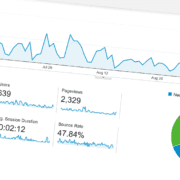Is Your Healthcare Practice Making These Digital Mistakes?
When running a successful healthcare practice in the digital age, most administrators focus on HIPAA regulations and strictly following them to keep patients’ PHI safe.
But there’s more to digital than what you can’t do online!
With the public face of your digital presence (website, social media and online listings), there’s a lot you can do to market your practice successfully (while still adhering to HIPAA).
We’d like to share five things many healthcare practices are missing or using incorrectly in their digital presence:
1. Have bad NAP?
- NAP refers to “Name, Address and Phone Number” — the core to all online business information. These three data fields represent your business’s most valuable contact information.
- When you originally set up your digital listings (social media, Yelp, Yellow Pages, etc.), you may not have listed your information consistently across all sites. The listing service may have also auto-generated a page by pulling information from your website.
- When your NAP is inconsistent across the web, it creates SEO havoc. You may not be getting as high on Google or other search results pages, thus losing potential customers.
- If your patients and clients are seeing your name or address inconsistently listed, it confuses them and erodes your brand.
2. Your site is abandoned (and sad)
- Back in the “old days” of websites, most companies paid someone to put their brochure content online, thus building their first website…and never updating it until it was time for a new website. Luckily, websites are now easier to update with new, fresh content. It’s critical that you invest time and energy into regularly refreshing your site with new blog posts, updated doctor bios and videos, new staff listings, new services and other relevant information.
- An abandoned site hurts your marketing efforts. When you don’t update your website frequently, search engines like Google think your site is stale and outdated which lowers it’s SEO ranking.
- Tip: Use a content calendar to plan what you’ll post to the website, and plan to post at least a few times a month. Each time you post a blog, you create a new page on your site (and updated content for your customers).
3. Got link juice?
- “Link juice” is what happens when you link to other sites from your site (outbound links to referring clinics, partners you work with or associations you belong to). It also accounts for links coming into your site (social media posts, online listings, partner clinics or associations you belong to, the local Chamber of Commerce or a board linking to your site).
- Without inbound and outbound links, you can be disconnected online—floating around with no digital friends. Search engines like Google don’t like that because it makes you seem less trustworthy. Link juice shows them that you play nice with others, and that others find you relevant (like when a trusted site such as LinkedIn is linking to you 50 times—one for each blog post you’ve shared and linked back to your site). Link juice is great for SEO and will help your site get to the top page of search results.
4. Your site and social don’t match your marketing
- Going hand-in-hand with an outdated site is a site that doesn’t match your business’ current marketing campaign. If you’ve updated your billboards, TV ads or other mass marketing messages, but your website doesn’t reflect or echo any of the current campaign, it will cause a disconnect between you and your audience.
- This same rule goes for your social media accounts—you’ll want to match your current campaign on your Facebook cover image, especially if you have a direct offer or call to action you’d like people to take. Remember—if people see one thing in the media and another thing online, it can cause confusion, and confusion causes inaction!
5. Getting too fancy with “micro-sites”
- Micro-sites originally seemed like a great solution to launching a new campaign or product without adding a new section to your primary website. A company would buy a new URL (web address) and build a completely new website for just one aspect of their business on this “micro-site,” then spend money to send traffic to it. This is actually detrimental to your overall user experience because it splits up your web traffic and trains your audience to go to a different website other than your primary site. Since most micro-sites were usually temporary, long-term benefits were never fully realized.
- Don’t split hairs with your marketing. Keep everything on one site–your primary website. Then, interlink to areas you’d like your audience to see or use in-bound links directly to landing pages created for specific promotions. This will help keep your brand strong, your message clear, your SEO optimized, and your audience happy!
As a healthcare professional, you’re doing well to focus on keeping your patients’ PHI safe. But beyond HIPAA, more attention to your digital presence will strengthen your brand and allow your practice to take advantage of all the benefits of digital communication and marketing.







